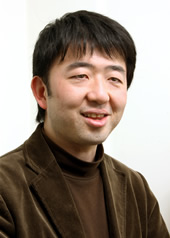2010/11/01
A step towards speech recognition - selective sound extraction from the noise
Lecturer Nobutaka Ono
(Department of Information Physics and Computing)

The essence of Lecturer Ono's research in sound source separation is extracting the sound you want from the random noise or accentuating sounds of a piano and a violin by removing percussive sounds from mixed music signals. Humans can distinguish the voice of a specific person at a party where many people gather, which is called the cocktail party effect. This lays the foundation for developing “mechanical ears” that automatically generate sentences from words spoken in the surrounding noise in order to create the age in which speech recognition is accessible to everyone.
Lecturer Ono led the successful experiment to produce clear sounds with little noise by applying special treatment to ambient noise recorded at stations in Tokyo. He got the idea that noise could be reduced by "changing the microphone array” that captures the noise based on the hypothesis that “multidirectional noises in the surroundings have the same property.” Microphones were mounted at the top of crystal-like shapes, for example square, regular tetrahedron, and cuboids. The correlation with “group theory” that addresses symmetry in mathematics is now being studied.
On the other hand, he also looks to researches using many microphones, and targets at a “distributed microphone array” to be applied to sound source separation and source localization by associating signals recorded with recording devices including IC recorders, mobile phones, and cassette tape recorders.
Speech recognition technology is necessary to recognize separated sounds with crystal-shaped microphone arrays and distributed microphone arrays, leading to new research on identifying isolation signals that are friendly to speech recognition devices in addition to research on speech recognition using source-separated signals. These efforts will strongly encourage the realization of “mechanical ears.”

